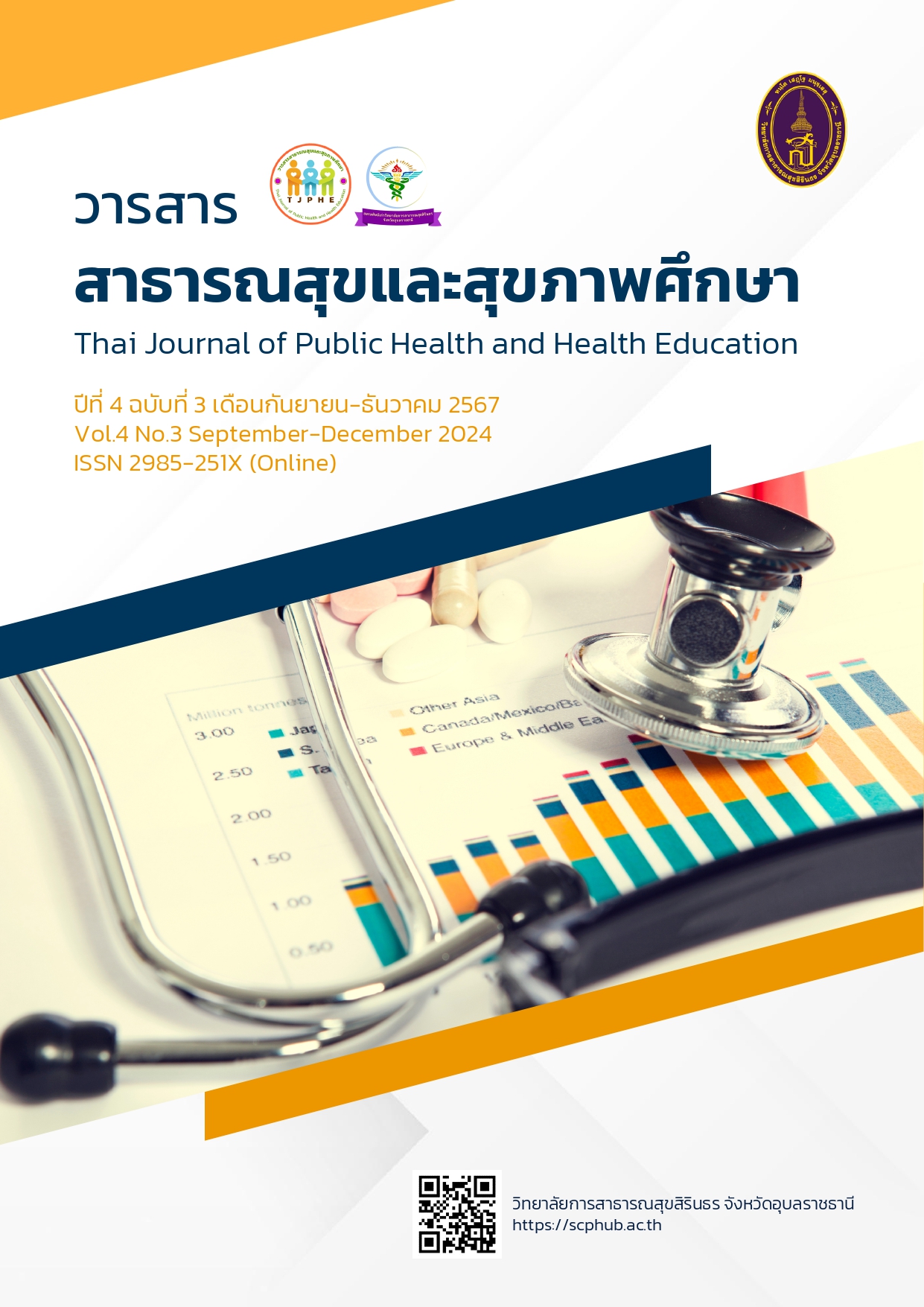การใช้ Procalcitonin เพื่อช่วยวินิจฉัยภาวะติดเชื้อแบคทีเรียของผู้ป่วย ในโรงพยาบาลสรรพสิทธิประสงค์ จังหวัดอุบลราชธานี
คำสำคัญ:
ค่าความจำเพาะ, ค่าความไว, โปรแคลซิโทนิน, ภาวะติดเชื้อแบคทีเรียบทคัดย่อ
การวิจัยแบบย้อนหลังนี้มีวัตถุประสงค์เพื่อศึกษาผลการวินิจฉัยภาวะการติดเชื้อแบคทีเรียของผู้ป่วยใน ความสัมพันธ์ของปัจจัยเพศและอายุกับผลการวินิจฉัยภาวะติดเชื้อแบคทีเรียของผู้ป่วยใน ความจำเพาะ ความไว และความแม่นยำของการทดสอบวินิจฉัยโปรแคลซิโทนินในโรงพยาบาลสรรพสิทธิประสงค์ ดำเนินการเก็บข้อมูลผู้ป่วยตั้งแต่เดือนกรกฎาคม 2564 ถึงเดือนธันวาคม 2566 โดยใช้แบบบันทึกผู้ป่วยเป็นเครื่องมือวิจัย กลุ่มตัวอย่างซึ่งเป็นผู้ป่วยในที่ได้รับการทดสอบโปรแคลซิโทนินและมีผลการวินิจฉัยโรค สุ่มตัวอย่างแบบเป็นระบบ จำนวน 480 คน วิเคราะห์ข้อมูลทั่วไปผู้ป่วยใน ค่าความจำเพาะ ค่าความไว และค่าพื้นที่ใต้เส้นโค้ง เพื่อดูความแม่นยำของโปรแคลซิโทนิน ใช้สถิติเชิงพรรณนา ได้แก่ ความถี่ ร้อยละ ค่ามัธยฐาน สถิติอนุมาน ได้แก่ การประมาณค่า 95% CI, Chi-Square และ Mann-Whitney U test ผลการศึกษาพบว่า กลุ่มตัวอย่างส่วนใหญ่เป็นเพศหญิง ร้อยละ 51.67 มีค่ามัธยฐานอายุ 60.50 ปี ร้อยละ 42.50 เป็นผู้ป่วยอายุรกรรม ผลการวินิจฉัยของผู้ป่วยในที่มีภาวะติดเชื้อแบคทีเรียอยู่ที่ร้อยละ 70.83 (95% CI=68.73-72.93) และพบว่าผลการวินิจฉัยภาวะติดเชื้อแบคทีเรียไม่มีความสัมพันธ์กับเพศแต่มีความสัมพันธ์กับอายุอย่างมีนัยสำคัญทางสถิติ (p value=.036) เมื่อกำหนดจุดตัดของโปรแคลซิโทนินที่ 0.90 µg/L ตามค่าอ้างอิงของโรงพยาบาล ได้ค่าความจำเพาะและค่าความไวของการทดสอบวินิจฉัยโปรแคลซิโทนิน ร้อยละ 91.43 (95%CI=89.03-93.83) และร้อยละ 52.94 (95%CI=50.24-55.64) ตามลำดับ โดยมีระดับประสิทธิภาพการจําแนกความถูกตองอยู่ในระดับดีตามที่แสดงโดยพื้นที่ใต้เส้นโค้งที่ 0.80 อย่างไรก็ตามเมื่อกำหนดจุดตัดของโปรแคลซิโทนินที่ 0.50 µg/L ค่าความจำเพาะของการทดสอบจะอยู่ที่ร้อยละ 82.86 (95%CI=79.06-86.66) และค่าความไวในการทดสอบอยู่ที่ร้อยละ 63.53 (95%CI=60.93-66.13) โดยรวมแล้วการศึกษานี้ยืนยันว่าจุดตัดของโปรแคลซิโทนินที่ 0.90 µg/L มีความจำเพาะสูงถึงร้อยละ 91.43 โดยมีผลบวกปลอมเพียงเล็กน้อยและสามารถใช้แยกความแตกต่างระหว่างการติดเชื้อแบคทีเรียและไวรัสได้อย่างแม่นยำ ดังนั้นจึงสามารถใช้ตัวบ่งชี้ชีวภาพโปรแคลซิโทนินเพื่อช่วยวินิจฉัยภาวะการติดเชื้อแบคทีเรียและใช้ในการพิจารณาการให้ยาปฏิชีวนะโดยไม่จำเป็นได้
Downloads
เอกสารอ้างอิง
กัญฑิมาศ สิทธิกูล. (2558). ความแม่นยำของ Procalcitonin ในการตรวจหาภาวะติดเชื้อแบคทีเรียรุนแรงในผู้ป่วยเด็กวิกฤต. สืบค้นจาก https://www.thaipedlung.org/download/QSNICH_Kantimas_edited.pdf
กรมควบคุมโรค, กระทรวงสาธารณสุข. (2566). โรคปอดบวม, ปอดอักเสบ (Pneumonia). สืบค้นจาก https://ddc.moph.go.th/disease_detail.php?d=21
กองยุทธศาสตร์และแผนงาน, กระทรวงสาธารณสุข. (2566). สถิติสาธารณสุข พ.ศ. 2565 (Public Health Statistics A.D. 2022). สืบค้นจาก https://spd.moph.go.th/
ทองเปลว ชมจันทร์ และประภาพรรณ สิงโต. (2565). การติดเชื้อดื้อยาต้านจุลชีพหลายขนานในแผนกผู้ป่วยอายุรกรรม. วารสารการพยาบาลและสุขภาพ สสอท. 4(3), e2827.
ปรารถนา จานเขื่อง และจุฬาภรณ์ ตั้งภักดี. (2560). การประเมินเพื่อป้องกัน และเฝ้าระวังความก้าวหน้าของภาวะติดเชื้อ 5 ระยะในผู้ป่วยเด็ก. การประชุมวิชาการเสนอผลงานบัณฑิตศึกษา ระดับชาติและนานาชาติ 2560. สืบค้นจาก https://gsbooks.gs.kku.ac.th/60/nigrc2017/pdf/MMP23.pdf
ภัทริน ภิรมย์พานิช. (2558). Misconception in everyday practice biomarker: Procalcitonin-overuse to overdiagnosis?. การประชุมวิชาการ คณะแพทยศาสตร์ มหาวิทยาลัยธรรมศาสตร์. โรงพิมพ์มหาวิทยาลัยธรรมศาสตร์, 1, 114-119.
สำนักงานหลักประกันสุขภาพเขต 10 อุบลราชธานี. (2566). ระบบพื้นฐานข้อมูลเขต 10 อุบลราชธานี. สืบค้นจาก https://ubon.nhso.go.th/index.php
สถิติสุขภาพของสำนักงานสถิติแห่งชาติ (สสช). (2566). ค้นหาสถิติ. สืบค้นจาก https://www.nso.go.th/nsoweb/nso/statistics_and_indicators?impt_branch=305
สมาคมโรคติดเชื้อแห่งประเทศไทย, กรุงเทพมหานคร. (2566). ความรู้สำหรับประชาชนสืบค้นข้อมูล. สืบค้นจาก https://www.idthai.org/
สุณิสา ฉายแสง. (2566). สถานการณ์การดื้อยาต้านจุลชีพของแบคทีเรีย 8 ชนิดที่ติดเชื้อในกระแสเลือดและผลการวิเคราะห์ที่เกี่ยวข้อง ในโรงพยาบาลดำเนินสะดวก. วารสารศาสตร์สาธารณสุขและนวัตกรรม, 3(2). 81-95.
Azzini, A. M., Dorizzi, R. M., Sette, P., Vecchi, M., Coledan, I., Righi, E. et al. (2020). A 2020 review on the role of procalcitonin in different clinical settings: an update conducted with the tools of the Evidence Based Laboratory Medicine. Annals of Translational Medicine, 8(9), 610. https://doi.org/10.21037/atm-20-1855
Cleland, D. A., & Eranki, A. P. (2023). Procalcitonin. National Library of Medicine. Retrieved from: https://www.ncbi.nlm.nih.gov/books/NBK539794/
Hatzistilianou, M. (2010). Diagnostic and prognostic role of Procalcitonin in infections. The Scientific World Journal, 10, 20890583. https://doi.org/10.1100/tsw.2010.235
Hoeboer, S. H., van der Geest, P. J., Nieboer, D., & Groeneveld, A. B. J. (2015). Procalcitonin as a diagnostic marker in sepsis. Clinical Microbiology and Infection, 21(5), 474-481. https://doi.org/10.1016/j.cmi.2014.11.024
Davies, J. (2015). Procalcitonin. Journal of Clinical Pathology, 68(9), 736-740.
Kamat, I. S., Ramachandran, V., Eswaran, H., Guffey, D., & Musher, D. M. (2020). Procalcitonin to distinguish viral from bacterial pneumonia: A systematic review and meta-analysis. Clinical Infectious Diseases, 70(3), 538-542.
Meisner, M. (2014). Update on Procalcitonin measurements. Annals of Laboratory Medicine, 34(4), 263–273.
Müller, F., Christ-Crain, M., Bregenzer, T., Krause, M., Zimmerli, W., Mueller, B., & Schuetz, P. (2010). Procalcitonin levels predict bacteremia in patients with community-acquired pneumonia: A prospective cohort trial. Clinical Infectious Diseases, 138(1), 121-129.
Ngamjarus, C. (2021). Sample size calculation for health science research. 1st ed. Khon Kaen University Printing House.
Ngamjarus, C., & Pattanittum, P. (2024). n4Studies: Application for sample size calculation in health science research (Version 2.3). App Store.
Ray, P., Manach, Y., Riou, B., & Houle, T. (2011). Statistical evaluation of a biomarker. Anesthesiology, 112(5), 1023-1040. https://doi.org/10.1097/ALN.0b013e31820f91d4
Samsudin, I., & Vasikaran, S. D. (2017). Clinical utility and measurement of Procalcitonin. Clinical Biochemist Reviews, 38(2), 59-68.
Schuetz, P., Christ-Crain, M., Wolbers, M., et al. (2007). Procalcitonin-guided antibiotic therapy and hospitalization in patients with lower respiratory tract infections: A prospective, multicenter, randomized controlled trial. BMC Health Services Research, 7, 102.
Wacker, C., Prkno, A., Brunkhorst, F. M., & Schlattmann, P. (2023). Procalcitonin as a diagnostic marker for sepsis: A systematic review and meta-analysis. Lancet Infectious Diseases, 13, 426-435.
Wayne, W. D. (1995). Biostatistics: A foundation of analysis in the health sciences (6th ed.). John Wiley & Sons, Inc.
World Health Organization. (2024a). Report signals increasing resistance to antibiotics in bacterial infections in humans and need for better data. Retrieved from: www.who.int/news/item/09-12-2022-report-signals-increasing-resistance-to-antibiotics-in-bacterial-infections-in-humans-and-need-for-better-data
World Health Organization. (2024b). World health statistics 2024-Monitoring health for the SDGs, Sustainable Development Goals. Retrieved from: https://www.who.int/publications/i/item/9789240094703
Yang, X., Zeng, J., Yu, X., Wang, Z., Wang, D., Zhou, Q., et al. (2023). PCT, IL-6, and IL-10 facilitate early diagnosis and pathogen classifications in bloodstream infection. Annals of Clinical Microbiology and Antimicrobials, 22(1), 103.
Yingkhajorn, S., Sutthichot, S., Hongthong, N., Boonrod, T., Simla, W., & Sriraksa, S. (2021). Occurrence of antimicrobial resistance in hospitals: A systematic review and meta-analysis. Journal of Health Science, 30(5), 916-927.
ดาวน์โหลด
เผยแพร่แล้ว
รูปแบบการอ้างอิง
ฉบับ
ประเภทบทความ
สัญญาอนุญาต
ลิขสิทธิ์ (c) 2024 วิทยาลัยการสาธารณสุขสิรินธร จังหวัดอุบลราชธานี

อนุญาตภายใต้เงื่อนไข Creative Commons Attribution-NonCommercial-NoDerivatives 4.0 International License.
บทความที่ได้รับการตีพิมพ์ในวารสาร วารสารสาธารณสุขและสุขภาพศึกษา (Thai Journal of Public Health and Health Education) เป็นลิขสิทธิ์ของ วิทยาลัยการสาธารณสุขสิรินธร จังหวัดอุบลราชธานี















